UNDERSTANDING MOLD
Why it Grows, How to Clean it, and How to Prevent it
By Rick Trottier, Product Specialist and Key Account Manager
Correct Building Products, LLC
What is Mold?
Mold is the common term used to describe a growth on the surface of
organic matter,
caused by fungi, especially in the presence of dampness. Mold is mother
nature's way
of recycling organic matter. Every cubic foot of air has thousands of
mold spores floating
within it. Every surface - natural or man made, inside or out - has
thousands more
spores that have settled upon it.
A fungus (pl. fungi) may be any of a large number of simple
microorganisms that do not
need energy from light for growth. The fungi bear microscopic spores
that are produced
in enormous quantities, are always present in the air, and spread via
air currents. They
are often water repellent and are resistant to desiccation (drying out).
"Mold" is often used interchangeably with the word mildew. These are the
generic terms
that describe a variety of microorganisms, including fungi, algae,
rusts, yeasts, and
bacteria.
Under a microscope, mold has an octopus-like structure. Its legs attach
to a surface in a
web-like manner. Once a mold has successfully colonized, it turns a dark
color and
releases thousands of new spores.
What Makes it Grow?
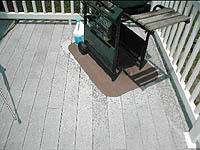 Molds need three things to grow: food, water, and temperate weather.
When the spores are in favorable environment, they will germinate. What
constitutes a favorable environment is different for each species. Since
the spores settle out of the air, they will be more prevalent on
horizontal surfaces and are generally not found below overhangs, under
porches or patios, or on the undersides of decks, even in damp areas.
The colonies do not migrate, like a rot, but rather establish colonies
and release more spores. The reason we recommend regularly sweeping the
deck is the colonies are typically invisible; they only change color
after they have released spores and died. Sweeping the deck removes the
food source (pollen, dirt) and removes any dormant spores as well. After
landing on a host material, a spore must obtain sufficient moisture to
find enough food. Without moisture, the spores will lie dormant until
favorable conditions occur.
Molds need three things to grow: food, water, and temperate weather.
When the spores are in favorable environment, they will germinate. What
constitutes a favorable environment is different for each species. Since
the spores settle out of the air, they will be more prevalent on
horizontal surfaces and are generally not found below overhangs, under
porches or patios, or on the undersides of decks, even in damp areas.
The colonies do not migrate, like a rot, but rather establish colonies
and release more spores. The reason we recommend regularly sweeping the
deck is the colonies are typically invisible; they only change color
after they have released spores and died. Sweeping the deck removes the
food source (pollen, dirt) and removes any dormant spores as well. After
landing on a host material, a spore must obtain sufficient moisture to
find enough food. Without moisture, the spores will lie dormant until
favorable conditions occur.
There are many common food sources, such as dust, pollen, and other
pollutants (see photo above). Water is essential for the growth of mold.
Greater than 60% humidity, steady dampness, and temperatures between 40
and 100 degrees F, are the factors most conducive to growth. It will
stay dormant if the conditions are too dry or too cold, or if there are
insufficient food sources.
How to clean it...
It is important that any cleaning procedure fully remove the web-like
"legs" of the colonies, penetrate the water-repellant outer surface, and
remove the food source. The ideal cleaner is a steam-power sprayer,
although normal power washers, or combinations of bleach, water, and
laundry detergent are also effective. In all cases, use the correct
protective equipment such as safety glasses, dust-mask and gloves. Since
mold will die at temperatures above 140 F, we have had great success
with a steam-power sprayer at 250 + degrees removing the mold. (See Photos B and C)
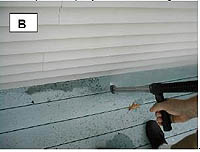
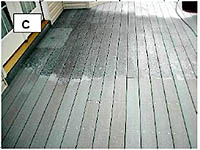
If staining is still present, follow with a sodium percarbonate product
(OxiDeck) powder sprinkled directly on the stains, left damp for 6+
hours, and rinsed to help remove the stains (see photos D, E). Bleach,
laundry soap and water can also be scrubbed onto the mold to help with
the removal of the mold.(see photo F).
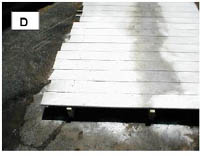
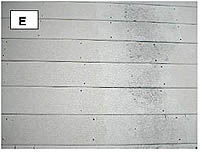
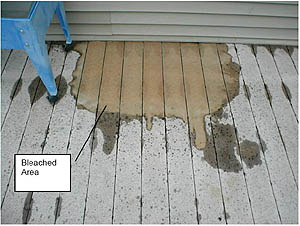
How to prevent it...
Preventing the growth of mold is as simple preventing the three factors
that it needs to live. Keep the deck as dry as possible, and remove the
food source by sweeping or washing. Here is a checklist of
mold-preventive steps:
- Gap the decking properly (minimum 1/8') for drainage
- Assure that the gutters do not discharge onto the deck
- Check that gutters are not backed up and overflowing onto deck dryer
vent does not discharge directly onto or around deck
- Pitch the deck properly away from the house for drainage (minimum 1/8"
in 8')
- Avoid the use of bark mulch around, on or under the deck (bark mulch
is typically heavily laden with mildew spores)
- Avoid the use of lawn or plant fertilizer on the deck (such as
overspray from lawn fertilizer or Miracle-Gro from potted plants)
- Sweep the deck every week, especially when pollen is heavy (typically
spring and late summer)
Correct Building Products also recommends No More Mildew from National
Allergy Supply as a spray-on preventive measure.
|





 Molds need three things to grow: food, water, and temperate weather.
When the spores are in favorable environment, they will germinate. What
constitutes a favorable environment is different for each species. Since
the spores settle out of the air, they will be more prevalent on
horizontal surfaces and are generally not found below overhangs, under
porches or patios, or on the undersides of decks, even in damp areas.
The colonies do not migrate, like a rot, but rather establish colonies
and release more spores. The reason we recommend regularly sweeping the
deck is the colonies are typically invisible; they only change color
after they have released spores and died. Sweeping the deck removes the
food source (pollen, dirt) and removes any dormant spores as well. After
landing on a host material, a spore must obtain sufficient moisture to
find enough food. Without moisture, the spores will lie dormant until
favorable conditions occur.
Molds need three things to grow: food, water, and temperate weather.
When the spores are in favorable environment, they will germinate. What
constitutes a favorable environment is different for each species. Since
the spores settle out of the air, they will be more prevalent on
horizontal surfaces and are generally not found below overhangs, under
porches or patios, or on the undersides of decks, even in damp areas.
The colonies do not migrate, like a rot, but rather establish colonies
and release more spores. The reason we recommend regularly sweeping the
deck is the colonies are typically invisible; they only change color
after they have released spores and died. Sweeping the deck removes the
food source (pollen, dirt) and removes any dormant spores as well. After
landing on a host material, a spore must obtain sufficient moisture to
find enough food. Without moisture, the spores will lie dormant until
favorable conditions occur.
